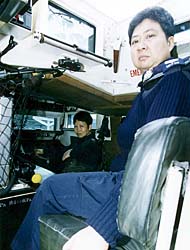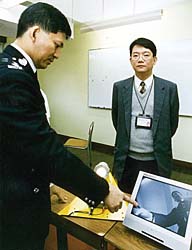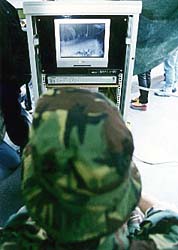



















| |
 Driver's seat. Women Sergeants Wu and Liu in their Saxon |
THERE are currently seven Saxons in the
Force, all belong to the Police Tactical Unit. These armoured vehicles weigh nine tonnes (11
tonnes if fully loaded), come equipped with tear gas, a bullet-proof windscreen, puncture-proof
tyres, and can be electrified for security.
The mammoth vehicle is purpose built for transporting police into riot scenes where it becomes a command post, and operating one, which requires much skill, has traditionally been the domain of male police officers Ал until now. Two experienced Police Driving School Instructors, Wu Yuet-ngor and Liu Kit-hing, have just completed intensive training to operate the vehicle and have acquired the qualification to become the Force's first two women Saxon instructors. |
|
And the two women sergeants are delighted. "I enjoy the challenge of driving different kinds of vehicles, especially ones that are unique and require skill and respect on the part of the operator," said Women Sergeant Wu Yuet-ngor, who has been a driving instructor at PDS for five years. "There are only seven Saxons in Hong Kong Ал all Force owned. So, I was very happy to be recommended to operate these armoured vehicles, which play an important role in the event of a major disturbance or riot." For Women Sergeant Liu Kit-hing, who has been a driving instructor for 15 years, acquiring the qualification to become a Saxon instructor is "like a dream come true". "Apart from the feeling of satisfaction and achievement," she said, "being the first two woman Saxon instructors makes the experience more meaningful. Posts that seemed to be dominated by male police officers in the past are now opening up for female officers. From the perspective of human resources management, such a change will bring about a positive and progressive effect in the Force."
Both Woman Sergeants Wu and Liu underwent three-weeks of intensive training, during the course of which they drove the huge vehicle through urban areas like Tsim Sha Tsui and on Tolo Highway. "We attracted a lot of attention and salutes from road users," they smiled. | |
stop influx of illegal immigrants | |
 SSP OPS Fung Kwok-on testing the static infra-red scanner |
POLICE efforts to stop illegal immigrants
sneaking across the mainland/Hong Kong land boundary have received a boost with the
installation of static infra-red scanners at the boundary crossings Ал the latest addition to the
Force's anti-illegal immigration equipment systems which are now fully operational at the
three check points at Man Kam To, Lok Ma Chau and Sha Tau Kok.
Senior Superintendent with Operations Wing at Police Headquarters, Fung Kwok-on, said the static infra-red scanners were variants of portable infra-red scanners introduced late last year and when used in combination with each other "form a very effective under-vehicle surveillance system to check for illegal immigrants coming into Hong Kong by hiding under cross-border vehicles". The new detection equipment comes at a time when cross-boundary traffic is steadily increasing. |
|
The number of illegal immigrants caught hiding under vehicles at boundary crossing points showed a consistent increase from 1,001 in 1993 to 3,646 in 1998, representing about 45 per cent of illegal immigrants taking land routes to Hong Kong. In December 1998, a total of 436 people hiding under vehicles were discovered. Prior to the introduction of the infra-red scanners, officers at the boundary crossings relied on physical checks, as well as inclined mirror and portable mirror surveillance. Designed and produced in-house by police officers, the low-cost new system is handy, allows no blind spots, ensures 100 per cent checks without interrupting normal cross-boundary traffic, and very much improves the working conditions of officers responsible for such checks. SSP Fung stressed that although there was no sudden upsurge in illegal immigrants lately, police spare no effort in their battle to halt illegal immigration. |  An officer using the new system at the boundary |

![]()
